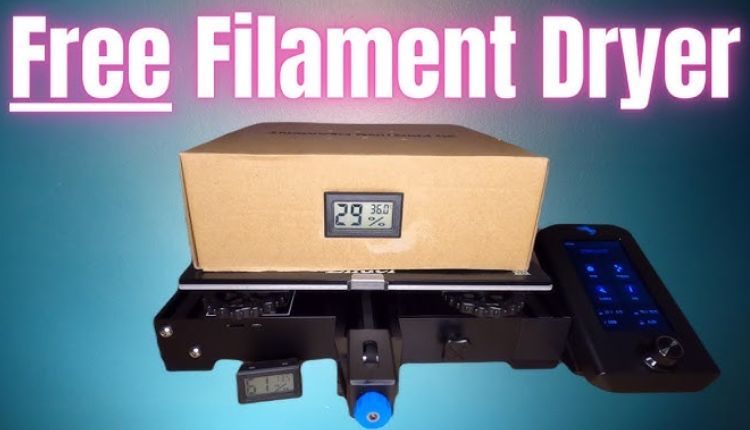Filament dryers are quite necessary for keeping moisture-sensitive materials like nylon, PETG, and PVA safe. During the moisture season in certain areas (like China, India, and more), 3D prints start to fail considerably more than anyone would expect.
This is why a dryer can keep your filaments ready-to-print while avoiding stringing, weak parts, and print failures. But what happens when your dryer isn’t working properly? In this article, we’re discussing why your filament dryer isn’t drying and the three possible fixes surrounding it.
1. Drying Not Heating At All
The most obvious issue is when the filament dryer doesn’t heat up in the first place. You see, drying relies on sustained temperature, and a dryer that never warms is basically nothing more than a storage box. This is useless for most people because then, you wouldn’t be able to properly get your filaments print-ready, because as soon as you pull it out, in just a matter of a few hours, the moisture is going to take over.
So, what are some of the reasons why it happens?
- Burned-out heating element:
Firstly, your heating element or filament could be burned out. This includes heating coils or ceramic plates inside the dryer, which degrade over time, especially if you use the dryer often.
- Blown fuse or power failure:
An internal fuse can sometimes also blow if there’s a power surge, and it is common in countries with unstable electricity.
- Thermal protection lockout:
Some dryers also have safety cutoffs that can disable heating if there was overheating in the last session.
The Fix:
First, check your power source and plug in your dryer directly into a wall outlet. Sometimes, a power strip cannot provide a stable power supply. There are some filament dryers that come with a manual reset button to restore power after the overheating occurred in the last session.
Lastly, you can also replace its fuse or simply contact your support. If you have a warranty, you might get some help.
2. Dryer Heats, But the Filament Isn’t Drying
On the contrary, your filament can also start heating when the power is on. To make things interesting, sometimes, it can get warm too and appear to run normally. However, the filament still comes out brittle, stringy, or full of moisture bubbles.
This is quite infuriating since, rather than no heating at all, you are stuck in confusion because your dryer was indeed working but not doing its job properly. Here’s why it happens:
- Poor airflow:
The fan inside the dryer circulates warm air, but if it’s broken or blocked, heat won’t go directly to the filament. This is the common cause of the aforementioned issue.
- Full chamber:
If you try to fit many filaments in hopes of drying them all, you will see that the air circulation will be limited, leaving many sections of the filaments damp. This gives the illusion that your filament dryer is not working properly.
- Bad dryer settings:
Poor dryer settings will leave filaments undried because each filament requires specific heat and time levels. PLA can degrade if overheated, while nylon needs around 12 hours at 70–80 °C.
The Fix:
First, you should inspect the fan and listen to the airflow. This is an old yet reliable method because if the fan is weak or silent, you might need to get it replaced. Contact the company’s customer support, or if you know what you’re doing, you can replace it yourself.
Secondly, always use the correct drying profiles for each filament. PLA, PETG, Nylon, and others, all of them would dry at different temperatures compared to each other. Lastly, you should check the chamber cover for cracks or a poor fit. That’s because even if there is a little that allows in the airflow, it can ultimately ruin your entire drying experience.
3. Dryer Starts But Stops Heating
Another common problem is when the dryer starts to heat up initially but then shuts down through the cycle. This could become an issue because it leaves your filament partially dried, resulting in your money being lost during the 3D printing process. In some cases, it can be worse because it can cool down mid-cycle, allowing reabsorption.
Here’s why this could happen:
- Faulty Thermostat or Sensor:
Sometimes, the internal temperature sensor is damaged and can misread or shut off the whole system. This way, the dryer starts but stops heating in between the processes.
- Unstable household voltage:
In areas with fluctuating electricity supply, dryers will automatically shut off to protect the dryer. But how do you actually fix this issue?
The Fix:
There are a variety of fixes you can try for these issues. Starting with improving the ventilation. You should always put the dryer in an open space and not against the walls or even inside your enclosure. This way, the excess heat can dissipate and it won’t overheat.
The second fix to try is to reduce the cycle setting. Instead of having the dryer run at the maximum temperature, try moderate heat for longer periods, as it will also reduce the risk of your dryer overheating.
You can also check the internal sensor that might need replacement at this point.
Final Verdict
A filament dryer that won’t heat or dry properly not only wastes electricity, but it also destroys the print quality and can cost you money as well. That’s why you should aim to get a reliable filament dryer like the one that Chitu System offers.
Lastly, if you’re looking for more 3D printer accessories, check out Chitu System’s 3D printer product catalog.






